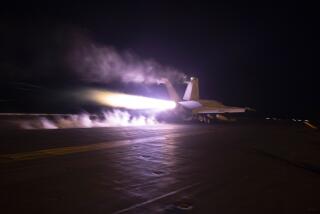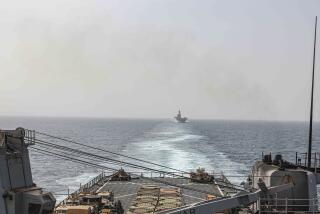NATO helicopters join Libya mission
- Share via
Reporting from Tripoli, Libya — French and British attack helicopters hit targets in Libya in the first use of such aircraft as part of the NATO-led campaign against the government of Moammar Kadafi, authorities said Saturday.
The helicopters, including British Apaches firing Hellfire missiles and 30-millimeter cannon rounds, struck targets around Port Brega, a strategic oil port that is the easternmost city still under the control of Kadafi’s forces. The targets hit included a radar installation and a military checkpoint, officials said.
The helicopters flew from British and French ships in the Mediterranean and returned to the vessels afterward, authorities said. No injuries to the crews or damage to the aircraft was reported.
“This successful engagement demonstrates the unique capabilities brought to bear by attack helicopters,” said Canadian air force Lt. Gen. Charles Bouchard, NATO commander for the Libya mission.
Meanwhile, more explosions rocked Tripoli on Saturday, apparently the latest in a punishing series of NATO-led bombing raids on the Libyan capital. There was no immediate word on damage or injuries.
The deployment of attack helicopters in Libya after much debate could represent a significant escalation of the 3-month-old conflict that pits rebels against forces loyal to Kadafi, who has led the oil-rich nation for more than four decades. Rebels who first rose against Kadafi in February now control most of eastern Libya, while Kadafi remains in power in Tripoli and much of the west.
North Atlantic Treaty Organization forces are acting under a United Nations mandate to protect civilians from Kadafi’s forces, a mission that has limited the mobility of his troops and in effect aided the rebels’ cause.
Rebel leaders who have been pushing NATO to step up attacks hailed the helicopter deployment. Until the helicopter strikes, the Western-led alliance had deployed fast-flying jet fighters and drone aircraft and fired missiles from offshore vessels.
Although helicopters have indisputable strengths — they can get closer to targets than high-altitude jet fighters and hover over the battlefield — the aircraft are also more vulnerable to ground fire, including ground-to-air missiles. The fear that a helicopter with a foreign crew could be shot down is probably one reason why NATO, which says it has no troops on the ground, took so long to decide to deploy them.
It was unclear whether a limited number of helicopters will be decisive in the battle for Libya or will drive Kadafi from power, a stated goal of NATO powers. Rebels have made recent advances in the western mountains and in the western coastal city of Misurata, 120 miles east of Tripoli. But the major east-west front outside Port Brega has been static for several months. And Kadafi has declared that he will not leave.
Last week NATO said it was extending its mission in Libya for another 90 days, signaling that a military campaign initially expected to last weeks could drag on for months more.
Port Brega is an important oil refining and shipping center and lies along the strategic coastal road from Benghazi, the rebel stronghold, to Tripoli, which passes through Libya’s major population centers.
Port Brega changed hands several times during the early days of the uprising against Kadafi. But the city wound up under government control while the next city to the east, Ajdabiya, about 50 miles away, remained in rebel hands. The front line separating the government and rebel armies is said to be about halfway between the two cities.
Whether the helicopter attacks signal the beginning of a long-anticipated rebel offensive toward Port Brega and the west remains to be seen.
More to Read
Sign up for Essential California
The most important California stories and recommendations in your inbox every morning.
You may occasionally receive promotional content from the Los Angeles Times.










